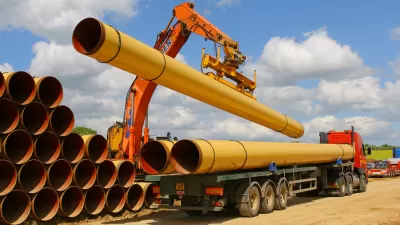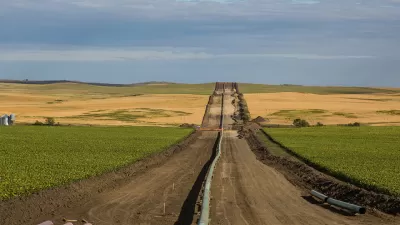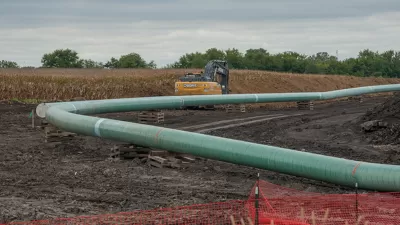Following through on a January executive action, President Trump announced Friday that he was approving the oil pipeline that his predecessor had rejected over a year ago. Oil is already flowing from Steele City, Nebraska to Gulf Coast refineries.

On March 24, President Trump's State Department "signed and issued a Presidential Permit to construct the Keystone XL Pipeline," announced the Calgary-based pipeline builder, TransCanada Corporation. As posted in January upon the president's signing a memorandum giving conditional approval to the Alberta to Nebraska pipeline, the pipeline will carry oil sands crude from Alberta and Bakken oil from North Dakota to the Gulf Coast refineries.
As readers who have followed the nine-year Keystone XL saga (see the Associated Press timeline, which begins in March 2008 with the original Keystone pipeline approval and September 2008 filing by TransCanada for a new Keystone XL route) will recall, former President Obama rejected the trans-national pipeline on Nov. 6, 2015.
Oil has been flowing through the southern, 487-mile leg of the pipeline (Phase III) from Cushing, Okla. to the Port Arthur, Texas region since January 2014. Phase II, from Steele City to Cushing, began operation in 2011. All that was missing was that Presidential Permit to enable a new (hence the "XL") trans-national crossing that required a Republican president to succeed President Obama.
Courtesy of Wikipedia: Keystone Pipeline Route, Phases 1 through 4.
However, the saga doesn't end with Friday's approval. The 1,179-mile Phase IV "shortcut" running from the oil sands of Alberta, Canada, through Montana to Steele City, Nebraska still faces hurdles before it can transport 830,000 barrels a day of oil sands crude from Alberta and Bakken crude from North Dakota, reports Clifford Krauss, The New York Times' national energy business correspondent.
It needs the approval of the Nebraska Public Service Commission and local landowners who are concerned about their water and land rights. Protests are likely since the project has become an important symbol for the environmental movement, with the Canadian oil sands among the most carbon-intensive oil supplies.
Krauss describes the "mixed-blessing" reaction by Prime Minister Justin Trudeau: good for the Canadian economy, but a likely setback for meeting his climate targets. [See related post this month on Trudeau's award from the energy industry.]
What happened to U.S.-manufactured steel for the pipeline?
Remember President Trump's insistence, solidified in a presidential memorandum on Jan. 24, that pipelines that run through the United States be manufactured domestically?
"We are -- and I am -- very insistent that if we're going to build pipelines in the United States, the pipe should be made in the United States," Trump said on Jan. 24. [Cleveland.com]. Krauss writes that "the White House has since suggested that the Keystone project would not be subjected to those rules because it is not a new project."
However, the Sierra Club provides a different explanation for Trump's reversal: "According to reports, TransCanada's threat to continue [it's $15 billion] NAFTA suit contributed to the White House decision to renege on Trump's promise that the pipeline would be made with U.S. steel." An hour after President Trump made his announcement, TransCanada dropped its suit, the Club reports.
Notwithstanding President Trump's announcement in the White House on Friday that "[i]t’s a great day for American jobs and a historic moment for North American and energy independence," don't expect President Trump to appear at any Ohio steel plants announcing new jobs.
FULL STORY: U.S., in Reversal, Issues Permit for Keystone Oil Pipeline

Study: Maui’s Plan to Convert Vacation Rentals to Long-Term Housing Could Cause Nearly $1 Billion Economic Loss
The plan would reduce visitor accommodation by 25,% resulting in 1,900 jobs lost.

North Texas Transit Leaders Tout Benefits of TOD for Growing Region
At a summit focused on transit-oriented development, policymakers discussed how North Texas’ expanded light rail system can serve as a tool for economic growth.

Using Old Oil and Gas Wells for Green Energy Storage
Penn State researchers have found that repurposing abandoned oil and gas wells for geothermal-assisted compressed-air energy storage can boost efficiency, reduce environmental risks, and support clean energy and job transitions.

Private Donations Propel Early Restoration of Palisades Playground
Los Angeles has secured over $1.3 million in private funding to restore the Pacific Palisades playground months ahead of schedule, creating a modern, accessible space that supports community healing after recent wildfires.

From Blight to Benefit: Early Results From California’s Equitable Cleanup Program
The Equitable Community Revitalization Grant (ECRG) program is reshaping brownfield redevelopment by prioritizing projects in low-income and environmental justice communities, emphasizing equity, transparency, and community benefits.

Planting Relief: Tackling Las Vegas Heat One Tree at a Time
Nevada Plants, a Las Vegas-based nonprofit, is combating the city’s extreme urban heat by giving away trees to residents in underserved neighborhoods, promoting shade, sustainability, and community health.
Urban Design for Planners 1: Software Tools
This six-course series explores essential urban design concepts using open source software and equips planners with the tools they need to participate fully in the urban design process.
Planning for Universal Design
Learn the tools for implementing Universal Design in planning regulations.
Ascent Environmental
Borough of Carlisle
Institute for Housing and Urban Development Studies (IHS)
City of Grandview
Harvard GSD Executive Education
Toledo-Lucas County Plan Commissions
Salt Lake City
NYU Wagner Graduate School of Public Service






























